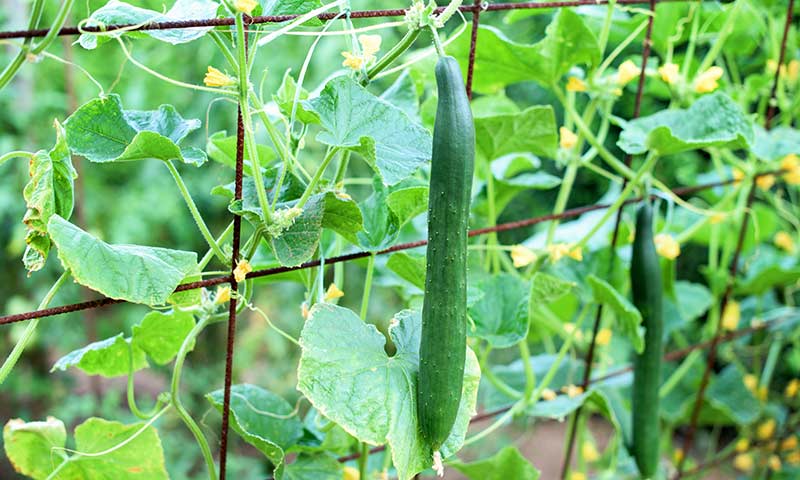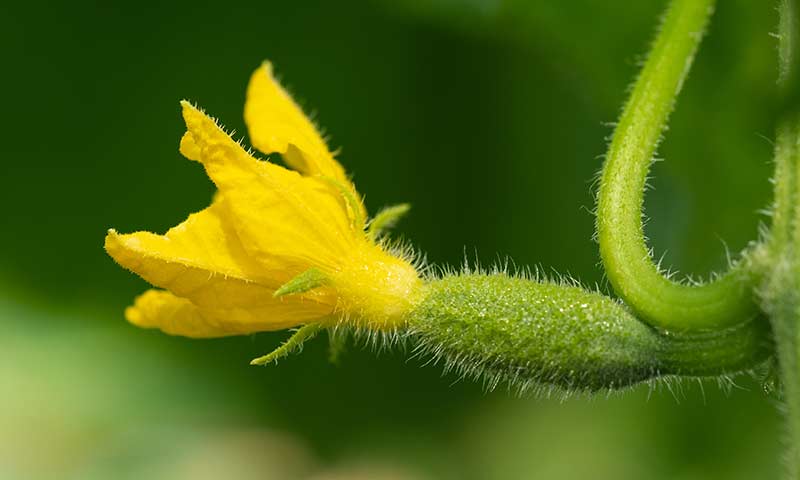How to Plant, Grow and Harvest Cucumbers
For many gardeners, harvesting homegrown cucumbers is a moment they look forward to all season. With just a few simple steps, you can enjoy the fresh flavor and satisfying crunch of a cucumber bounty — and share it with family and friends. Attractive cucumber plants can be grown in the ground, in raised beds or in containers. To make the most of your harvest, follow these basics and grow just the right cucumber for your space and culinary plans:
- Selecting the Right Cucumber
- Planting Cucumbers in the Garden
- Planting Cucumbers in Containers
- Fertilizing Cucumbers
- Managing Cucumber Pests and Diseases
- Harvesting Cucumbers
Selecting the Right Cucumber
When choosing the cucumber you want to grow, consider both your gardening space and the use you have in mind. Cucumbers have two different growth habits: bush and vining. Bush varieties are compact and don't require a trellis. They're ideal for growing in containers or small raised beds.
Vining cucumbers produce more fruit, but they require more space than bush varieties. Though some gardeners let vining cucumbers sprawl on the ground, that practice promotes disease.1 Growing vine cucumbers vertically on a trellis or netting helps improve airflow and discourage common fungal diseases such as powdery mildew, which can cause the loss of cucumber leaves meant to shade crisp cucumbers from intense sun.
Cucumbers also come in varieties suited to specific culinary uses. Slicing varieties and pickling varieties are available in both vining and bush types. Slicing varieties have tender skin and soft flesh ideal for fresh eating. Pickling cucumbers have tougher skin and flesh that stands up well when preserved. There are also numerous types of novelty cucumbers, such as the vining lemon cucumber, which grows in the shape and color of a lemon.

Planting Cucumbers in the Garden
Once you decide on the perfect cucumber varieties, it is time to plant. Start cucumbers from seeds sown right in your garden or buy healthy seedlings, also known as transplants, from your local garden center. Regardless of the type of cucumber you grow, the steps in the planting process are the same:
- Prepare your garden space. Cucumber planting happens well after the last chance of frost in spring, so you have plenty of time to prepare your vegetable garden space. If you're unsure when your area's last freeze usually happens, your county extension agent can help. To prep your garden for cucumbers, remove all weeds and loosen the soil with a trowel or shovel. Then incorporate a complete fertilizer such as Pennington Rejuvenate Plant Food All Purpose 4-4-4 to revitalize your soil with essential plant nutrients and nourish plants from the inside out.
- Check the soil temperature. Use a soil thermometer, available at most garden or hardware stores, to make sure your soil is warm enough for cukes. Don't plant until the soil temperature has reached 60 to 70 degrees Fahrenheit. Like zucchini and other cucurbits, cucumbers like it warm. They won't germinate and sprout in cold soil — and they grow best when temperatures range from 70° to 95°F.1
- Space your rows. Follow your seed packet or plant tag instructions on spacing your rows, but most cucumbers call for rows 3 to 4 feet apart. If you're planting vining cucumbers, install a trellis about 6 feet tall. Most bush cucumbers don't need extra support, but you can use tomato cages if you'd like.
- Plant your seeds or transplants. Plant according to your seed packet instructions for your variety. Planting 6 inches apart and 1 inch deep is typical for many cucumber varieties.2 If you're planting transplants, follow the instructions on the plant tag or label.
- Water thoroughly. Use a watering can with a sprinkler head or a hose on a gentle setting to water your newly planted seeds.
- Thin seedlings when they reach 4 inches tall. Leave just one strong cucumber seedling every 16 inches. Use pruning shears to cut off extra seedlings at the soil level. Don't pull them out or you may damage nearby roots. And don't worry — you'll get more cucumbers when there's less competition between plants.
- Water as needed. Keep your cucumber's soil consistently moist, but never soggy. This helps fruit stay hydrated and crisp. Water early in the day and avoid overhead watering to keep leaves dry and discourage fungal diseases.
Planting Cucumbers in Containers
To grow cucumbers in containers, start with large pots that can support both roots and vines. An 18-inch-diameter pot works well for vigorous cucumber plants. Fill the pot with a high-quality commercial potting mix formulated for use in containers. If you want to make your own mix, combine equal parts potting soil, compost and vermiculite, a mineral that helps retain moisture.
Plant three seeds 1 inch deep in the middle of each container. When seedlings have reached 4 inches tall, thin them to one seedling per container. If you're planting transplants, nursery-grown seedlings typically have more than one seed in the tiny pot.

Fertilizing Cucumbers
Adding fertilizer at planting time gets your cucumbers started right, but additional feedings help vines and fruits grow. Fertilize cucumber plants twice during the growing season with a balanced fertilizer specially formulated for garden fruits and vegetables, such Pennington Rejuvenate Plant Food Tomato & Vegetable 4-5-4 or Lilly Miller MORCROP Tomato & Vegetable Food 5-10-10.
Make your first post-planting feeding one week after your cucumber plants start blooming. Then feed your plants again three weeks later.3 Don't be tempted to overfertilize; too much fertilizer encourages more leaf and vine growth at the expense of your fruits.
Managing Cucumber Pests and Disease
Many cucumbers are susceptible to fungal issues and pests, especially when vines get crowded and air can't circulate well. Trellising helps improve airflow and circumvent some fungal problems. But stubborn fungal diseases such as downy mildew, powdery mildew and black rot call for prevention and intervention. When conditions favor disease development or your see signs of fungal problems, turn to liquid Daconil Fungicide Ready-To-Use to control, stop and prevent fungal disease.
For common pests such as cucumber beetles, aphids, squash bugs and flea beetles, you can pick the pesticide product that works best for you. Liquid Sevin Insect Killer Concentrate and Sevin Insect Killer Ready To Spray kill more than 500 insect pests by contact and keep protecting your cucumbers for up to three months.+ Just allow one day between using these two Sevin products and enjoying a cucumber harvest.
If you prefer dusting, Sevin Insect Killer Dust Ready To Use kills more than 150 insect pests and can be used up to three days before harvesting cucumbers. Sevin Sulfur Dust can be used as a dust or spray to control powdery mildew on cucumbers, too.

Harvesting Cucumbers
Once summer's sun and fun do their work, it's time for the best part of growing cucumbers: the harvest. When your cucumbers reach the proper size for the variety, cut the cucumbers from the stems using a sharp pair of pruning shears or garden scissors. Never tug or pull fruits from the plant. Cucumber vines and stems are fragile, and you may damage plants and end your harvest early.
Be prepared to harvest cucumbers every two days once they start to ripen. Cucumbers mature quickly, so harvest fruits before they get too large or overripe.
With a bit of preparation and a hand from GardenTech brands, cucumbers are easy-to-grow garden plants that offer bountiful harvests for the space they use. Whether you're growing a small bush of pickling cucumbers or a long row of slicing varieties, you can grow a prolific crop of cukes and satisfy those summer cravings.
+Except fire ants, fleas, ticks and mosquitoes.
Always read product labels thoroughly and follow instructions, including guidelines for pre-harvest intervals (PHI) and application frequency.
"Always read product labels thoroughly…" GardenTech is a registered trademark of Gulfstream Home & Garden, Inc.
Sevin is a registered trademark of Tessenderlo Kerley, Inc.
Pennington is a registered trademark of Pennington Seed, Inc.
UltraGreen is a registered trademark of Central Garden & Pet Company.
Sources:
1. S. Gray, "Vegetables: Growing Cucumbers in Home Gardens," Washington State University Extension, 2013.
2. R. Westerfield, "Growing Cucumbers in the Home Garden," UGA Extension, September 2013.
3. R. Jauron, "Growing Cucumbers in the Home Garden," Iowa State University Extension and Outreach, April 2002.
Get Monthly Gardening Advice!




